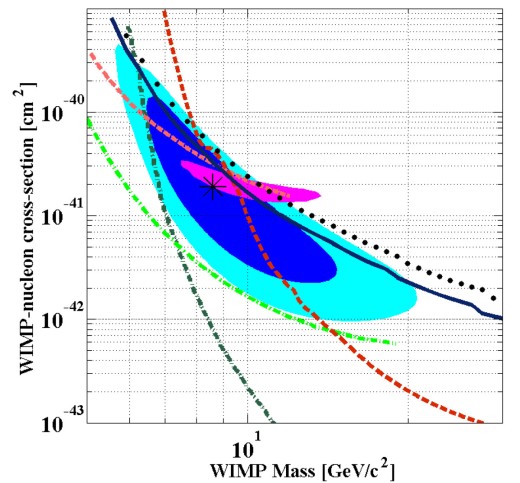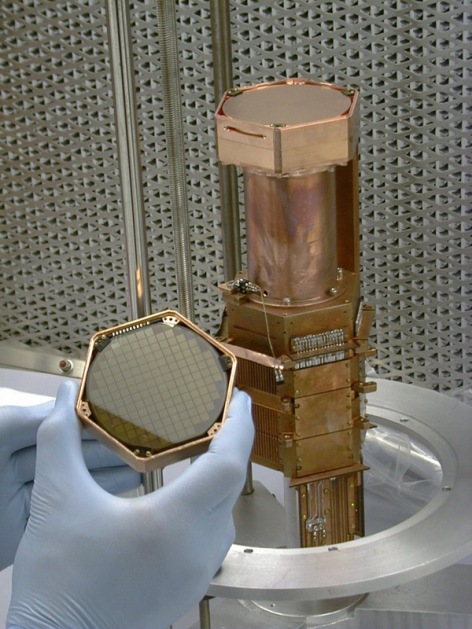Hard on the heels of the Alpha Magnetic Spectrometer (AMS) positron excess and possible dark matter report, we now have a hint of direct dark matter detection from the SuperCDMS Collaboration this month. A recent blog here on darkmatterdarkenergy.com discusses the detection of excess positron flux seen in the AMS-02 experiment on board the Space Shuttle. The two main hypotheses for the source of excess positrons are either a nearby pulsar or dark matter in our Milky Way galaxy and halo.
CDMS-II (CDMS stands for Cryogenic Dark Matter Search) is a direct dark matter detection experiment based in the Soudan mine in Minnesota. The deep underground location shields the experiment from most of the cosmic rays impinging on the Earth’s surface. Previously they had reported a null result based on their germanium detector and ruled out a detection. Now they have more completely analyzed data from their silicon detector, which has higher sensitivity for lower possible dark matter masses, and they have detected 3 events which might be due to dark matter and report as follows.
“Monte Carlo simulations have shown that the probability that a statistical fluctuation of our known backgrounds could produce three or more events anywhere in our signal region is 5.4%. However, they would rarely produce a similar energy distribution. A likelihood analysis that includes the measured recoil energies of the three events gives a 0.19% probability for a model including only known background when tested against a model that also includes a WIMP contribution.”
So essentially they are reporting a possible detection with something ranging from 95% to 99.8% likelihood. This is a hint, but cannot be considered a firm detection as it rises to the level of perhaps 3 standard deviations (3 sigma) of statistical significance. Normally one looks to see a 5 sigma significance for a detection to be well confirmed. If the 3 events are real they suggest a relatively low dark matter particle mass of around 8 or 9 GeV/c² (the proton mass is a little under 1 GeV/c², and the Higgs boson around 126 GeV/c²).

Figure: Error ellipses for CDMS-II and CoGeNT, assuming a dark matter WIMP explanation. Blue ellipses are the 68% (dark blue) and 90% (cyan) confidence levels for the CDMS-II experiment. The purple ellipse is the 90% confidence level for CoGeNT.
The figure shows the plane of dark matter (WIMP, or weakly interacting massive particle) cross-section on the y-axis vs. the WIMP mass on the x-axis. Note this is a log-log plot, so the uncertainties are large. The dark blue region is the 1 sigma error ellipse for the CDMS experiment and the light blue region is the 90% confidence error ellipse. The best fit is marked by an asterisk located at mass of 8.6 GeV/c² and with a cross-section a bit under 2 x 10^-41 cm². But the mass could range from less than 6 to as much as 20 or more GeV/c². And the cross-section uncertainty is over two orders of magnitude.
However, this is quite interesting as the error ellipse for the mass and interaction cross-section from this CDMS-II putative result overlaps well with the (smaller) error ellipse of the CoGeNT results. The CoGeNT experiment is a germanium detector run by a different consortium, but based in the same Soudan Underground Laboratory as the CDMS-II experiment! COGENT sees a possible signal with around 2.8 sigma significance as an annual modulated WIMP wind, with the modulation in the signal due to the Earth’s motion around the Sun and thus relative to the galactic center. The purple colored region in the figure is the CoGeNT 90% confidence error ellipse, and it includes the CDMS-II best fit point and suggests also a mass of roughly 10 GeV/c².
The DAMA/LIBRA experiment in Italy has for years been claiming a highly significant 9 sigma detection of a WIMP (dark matter) wind, but with very large uncertainties in the particle mass and cross-section. However both the COGENT results and this CDMS-II possible result are quite consistent with the centroid of the DAMA/LIBRA error regions.
And both the CoGeNT and DAMA experiments are consistent with an annual modulation peak occurring sometime between late April and the end of May, as is expected based on the Earth’s orbit combined with the Sun’s movement relative to the galactic center.
What we can say at this point is the hottest region to hunt in is around 6 to 10 GeV/c² and with a cross section roughly 10^-41 cm². Physicists may be closing in on the target area for a confirmed weakly interacting dark matter particle detection. We await further results, but the pace of progress seems to be increasing.
References:
https://darkmatterdarkenergy.com/2013/04/07/ams-positron-excess-due-to-dark-matter-or-not/ – Recent first results from AMS for positron excess
http://cdms.berkeley.edu/ – SuperCDMS Collaboration web site
http://arxiv.org/abs/1304.4279 – “Dark Matter Search Results Using the Silicon Detectors of CDMS II”
http://cdms.berkeley.edu/APS_CDMS_Si_2013_McCarthy.pdf – Kevin McCarthy’s presentation at the American Physical Society, April 15, 2013
http://cogent.pnnl.gov/ – CoGeNT website
https://darkmatterdarkenergy.com/2011/06/16/do-we-have-a-cogent-direct-detection-of-dark-matter/ – Discussion of CoGeNT 2011 results
http://arxiv.org/pdf/1301.6243v1.pdf – DAMA/LIBRA results summary, 2013


